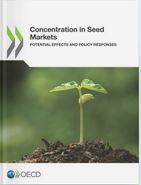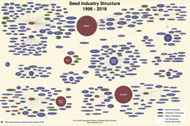 Topics Topics |
|
|
|
 Species Species |
|
|
|
|
|
First-ever “African Seed Access Index” launched to encourage vibrant seed sector serving smallholder farmers - Initial scorecards for four countries find most moving away from state-run monopolies; Farmers face long wait for new varieties, while package size can deter adoption
Nairobi, Kenya
March 12, 2015
A new analysis of African efforts to put more productive crop varieties into the hands of smallholder farmers finds progress but also significant challenges in a region still shaking off decades of complacent government seed monopolies.
The African Seed Access Index (TASAI)—the first ever initiative dedicated solely to monitoring the state of Africa’s rapidly evolving seed sector—issued detailed scorecards on seed development and distribution in Kenya, Uganda, South Africa and Zimbabwe, with a focus on increasing choices for smallholder farmers.
“We’ve known for a long time that a key reason yields on African farms lag far behind even those in other developing countries is that African farmers often lack access to improved varieties of staple crops such as maize, cowpea and sorghum,” said Ed Mabaya, assistant director of Cornell University’s International Institute for Food, Agriculture and Development (CIIFAD) and head of the TASAI project. “We think that by tracking indicators along the seed delivery chain—like the number of crop breeders, varieties released, industry competitiveness, availability of seed in small packages, and quality of the seed policy framework—investors and policymakers can target choke points that are impeding the flow of seeds to smallholder farmers.”
For example, TASAI’s analysis rates Kenya as poor in a key measure of industry competiveness: government-controlled companies still account for the lion’s share of seed sales, which can discourage new start-ups from entering the market. But South Africa, Uganda and Zimbabwe were rated excellent in this category as their governments have largely gotten out of the seed business. In South Africa, seed production appears to be thriving, but it scores poorly when it comes to making seeds accessible to smallholder farmers. Overall, Uganda’s seed sector is noted to be growing, but potentially burdened with weak seed policies and regulations. And Zimbabwe’s once vital seed sector is showing signs of decline.
“In Uganda, there is strong demand from farmers for our seeds, but we still face constraints that limit how much seed we can sell,” said Ms. Josephine Okot, CEO of Kampala-based Victoria Seeds Ltd. “We need access to more and better quality foundation seed developed by government-funded crop breeding programs and less stringent trade policies that would make it easier to import and export seeds.”
TASAI was developed by CIIFAD in collaboration with Market Matters Inc., a nonprofit organization that provides assistance to small- and medium-size enterprises in sub-Saharan Africa, among them a growing number of African-owned seed businesses. Mabaya said TASAI was inspired by the fact that money—from governments, private sector players and donors—is swiftly flowing to agriculture projects across Africa, but information available to guide investments is often anecdotal.
“There are enormous opportunities to develop sustainable seed production capacity in Africa,” he said. “But investments—whether in the form of private capital or development aid—are often constrained by a poor understanding of what each country needs.”
TASAI seeks to fill that void by systematically tracking 16 indicators across five categories that assess the vibrancy and competitiveness of the national seed sector by measuring the health of such things as research and development, service to smallholder farmers and industry competitiveness. (See table for complete list of indicators and their effect on seed access.)

Uneven Progress as Countries Confront Myriad Challenges
TASAI assessments released today focus on seed sectors in four pilot countries—Kenya, Uganda, South Africa and Zimbabwe. They reveal uneven—though in many places promising—progress towards competitive seed sectors that can supply famers with a wider menu of seed options.
For example, Kenya gets relatively good marks for its seed policies but scores poorly on efforts to purge fake seeds from the market, a problem that is unfortunately growing in many countries. South Africa gets strong marks for having a competitive seed sector and for shepherding new varieties from breeders to farmers relatively quickly. It takes an average of 12 months to release a new variety in South Africa, compared to three years in Kenya and Uganda, and almost two years in Zimbabwe.
But while South Africa stands out for having developed a large, mature and diverse commercial seed sector, it scores poorly compared to the other countries when it comes to making seeds available to farmers in small packages (less than five kilos). Kenyan seed companies, on the other hand, “outshine all other countries” in this category, according to TASAI’s analysis. Agriculture experts say that’s important because in Kenya, as in most other countries in the region, smallholder farmers account for the majority of crop production, and they want seeds in relatively small packages.
“It’s crucial that smallholder farmers in Africa have access to a wide range of crop varieties, because small farms are the mainstay of food production in the region,” said Joe Devries, the director of the Program for African Seed Systems at the Alliance for a Green Revolution in Africa (AGRA). “Seeds may not be a cure-all, but without a healthy seed sector, it’s hard to see how African farmers can satisfy the food demands of a population growing faster than any on earth and adapt to the effects of climate change that are rapidly altering farming conditions.”
When it comes to the sheer number of crop varieties released, the data offer a clear indication that South Africa’s seed sector is, in most respects, far more advanced than others in the region. For example, over the last three years, South Africa released 221 varieties of maize, while Kenya released 35, Uganda 12, and Zimbabwe 28. South Africa and Uganda get high marks for the quality of the national seed trade association—a critical link between the governments and private sector companies—while in Zimbabwe and Kenya, companies rate their association as only fair, indicating a potential need to intensify advocacy and support efforts.
TASAI’s analysis currently is focused on the four most important crops in each country in terms of area planted. Maize is the most widely cultivated crop in all four countries, but the overall mix varied. Kenya’s other top crops are sorghum, beans and cowpeas; in South Africa, it’s soybean, sunflower and wheat; in Uganda, beans, millet and sorghum; and in Zimbabwe, rounding out their top four are cotton, soybean and sorghum.
TASAI scorecards are based on extensive research in each country by local experts and will be updated annually. Mabaya said TASAI is preparing to release assessments of seed sector performance in four additional countries that should be available by mid-2015. He hopes that within two years, the database will include reports on more than 20 countries.
“Our goal is a simple, transparent, accurate and up-to-date index that keeps a running scorecard on seed sector development in Africa, particularly as governments and development agencies are placing bigger bets on agriculture to be the engine that pulls Africans out of poverty,” Mabaya said.
The African Seed Access Index (TASAI) is a collaborative initiative between Market Matters Inc., Cornell International Institute for Food and Agricultural Development and the Emerging Markets Program. Through this partnership, TASAI brings together research expertise from Cornell University with hands-on private sector development work from Market Matters Inc. More at http://tasai.org/about/.
More news from: TASAI - African Seed Access Index
Website: http://tasai.org Published: March 13, 2015 |
|
|
|
Better Food Venture's
AgTech Landscape 2019

|
| |
|
2019 THRIVE Top 50
landscape map

|
| |
|
Concentration in Seed Markets - Potential Effects and Policy Responses

(OECD December 2018)
|
|
Visualizing Consolidation
in the Global Seed Industry
1996–2018

Seed Industry Structure
1996-2018
Phil Howard
Associate Professor
Michigan State University
|
|
2017 Seed Company Family Tree
Ccreated Septebmer 2017
by Robert Walsh
WaSoo Farm, Elk Point, South Dakota |
 |
Syngenta Brands Family Tree
Ccreated January 2017 by Robert Walsh, WaSoo Farm, Elk Point, South Dakota
|
 |
| |
Rabobank's
World Vegetable Map 2018 |
 |
|
|